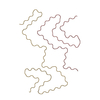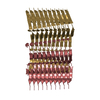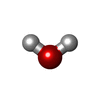+ Open data
Open data
- Basic information
Basic information
| Entry | Database: PDB / ID: 9cx6 | |||||||||
|---|---|---|---|---|---|---|---|---|---|---|
| Title | Cryo-EM filament structure in FTLD-synuclein | |||||||||
 Components Components | Alpha-synuclein | |||||||||
 Keywords Keywords | PROTEIN FIBRIL / amyloid / filament / synuclein / human brain / cryo-EM / fibril / MSA / FTLD | |||||||||
| Function / homology |  Function and homology information Function and homology informationnegative regulation of mitochondrial electron transport, NADH to ubiquinone / : / neutral lipid metabolic process / regulation of acyl-CoA biosynthetic process / negative regulation of dopamine uptake involved in synaptic transmission / negative regulation of norepinephrine uptake / response to desipramine / positive regulation of SNARE complex assembly / positive regulation of hydrogen peroxide catabolic process / supramolecular fiber ...negative regulation of mitochondrial electron transport, NADH to ubiquinone / : / neutral lipid metabolic process / regulation of acyl-CoA biosynthetic process / negative regulation of dopamine uptake involved in synaptic transmission / negative regulation of norepinephrine uptake / response to desipramine / positive regulation of SNARE complex assembly / positive regulation of hydrogen peroxide catabolic process / supramolecular fiber / mitochondrial membrane organization / regulation of synaptic vesicle recycling / negative regulation of chaperone-mediated autophagy / regulation of reactive oxygen species biosynthetic process / negative regulation of platelet-derived growth factor receptor signaling pathway / positive regulation of protein localization to cell periphery / negative regulation of exocytosis / regulation of glutamate secretion / dopamine biosynthetic process / SNARE complex assembly / regulation of norepinephrine uptake / response to iron(II) ion / positive regulation of neurotransmitter secretion / positive regulation of inositol phosphate biosynthetic process / regulation of locomotion / negative regulation of dopamine metabolic process / transporter regulator activity / regulation of macrophage activation / negative regulation of microtubule polymerization / synaptic vesicle transport / synaptic vesicle priming / dopamine uptake involved in synaptic transmission / protein kinase inhibitor activity / mitochondrial ATP synthesis coupled electron transport / regulation of dopamine secretion / dynein complex binding / positive regulation of receptor recycling / negative regulation of thrombin-activated receptor signaling pathway / cuprous ion binding / nuclear outer membrane / response to magnesium ion / positive regulation of endocytosis / positive regulation of exocytosis / synaptic vesicle exocytosis / kinesin binding / enzyme inhibitor activity / synaptic vesicle endocytosis / cysteine-type endopeptidase inhibitor activity / negative regulation of serotonin uptake / response to type II interferon / regulation of presynapse assembly / alpha-tubulin binding / beta-tubulin binding / phospholipase binding / behavioral response to cocaine / supramolecular fiber organization / phospholipid metabolic process / cellular response to fibroblast growth factor stimulus / inclusion body / axon terminus / Hsp70 protein binding / cellular response to epinephrine stimulus / response to interleukin-1 / regulation of microtubule cytoskeleton organization / cellular response to copper ion / positive regulation of release of sequestered calcium ion into cytosol / SNARE binding / adult locomotory behavior / excitatory postsynaptic potential / protein tetramerization / phosphoprotein binding / fatty acid metabolic process / microglial cell activation / ferrous iron binding / regulation of long-term neuronal synaptic plasticity / synapse organization / protein destabilization / PKR-mediated signaling / phospholipid binding / receptor internalization / tau protein binding / long-term synaptic potentiation / terminal bouton / positive regulation of inflammatory response / synaptic vesicle membrane / actin cytoskeleton / actin binding / growth cone / cellular response to oxidative stress / neuron apoptotic process / cell cortex / response to lipopolysaccharide / histone binding / microtubule binding / molecular adaptor activity / chemical synaptic transmission / mitochondrial outer membrane / amyloid fibril formation / negative regulation of neuron apoptotic process / oxidoreductase activity Similarity search - Function | |||||||||
| Biological species |  Homo sapiens (human) Homo sapiens (human) | |||||||||
| Method | ELECTRON MICROSCOPY / helical reconstruction / cryo EM / Resolution: 3.2 Å | |||||||||
 Authors Authors | Yang, Y. / Scheres, H.W.S. / Goedert, M. | |||||||||
| Funding support |  United Kingdom, 2items United Kingdom, 2items
| |||||||||
 Citation Citation | Journal: Neuropathol Appl Neurobiol / Year: 2025 Title: Identical Seeding Characteristics and Cryo-EM Filament Structures in FTLD-Synuclein and Typical Multiple System Atrophy. Authors: Patrick W Cullinane / Yang Yang / Viorica Chelban / Yee Yen Goh / Kirsten Ebanks / Toby Curless / Sarah Wrigley / Eduardo de Pablo-Fernández / Janice Holton / Sew Peak-Chew / Catarina ...Authors: Patrick W Cullinane / Yang Yang / Viorica Chelban / Yee Yen Goh / Kirsten Ebanks / Toby Curless / Sarah Wrigley / Eduardo de Pablo-Fernández / Janice Holton / Sew Peak-Chew / Catarina Franco / Amanda L Woerman / Henry Houlden / Thomas T Warner / Sjors H W Scheres / Michel Goedert / Zane Jaunmuktane /   Abstract: AIMS: The aim of this study is to identify the prevalence of frontotemporal dementia (FTD)/corticobasal syndrome (CBS) in a large cohort of pathologically confirmed cases of multiple system atrophy ...AIMS: The aim of this study is to identify the prevalence of frontotemporal dementia (FTD)/corticobasal syndrome (CBS) in a large cohort of pathologically confirmed cases of multiple system atrophy (MSA) and to determine the α-synuclein seeding characteristics and electron cryo-microscopy (cryo-EM) filament structure in frontotemporal lobar degeneration with MSA-type α-synuclein pathology (FTLD-synuclein). METHODS: The archives of the Queen Square Brain Bank (1989-2023) were searched for histologically confirmed MSA cases, and those with a clinical diagnosis of FTD/CBS were reviewed for pathological ...METHODS: The archives of the Queen Square Brain Bank (1989-2023) were searched for histologically confirmed MSA cases, and those with a clinical diagnosis of FTD/CBS were reviewed for pathological features of FTLD-synuclein. Phosphotungstic acid (PTA)-precipitated brain homogenates from FTLD-synuclein, dementia with Lewy bodies (DLB) and G51D SNCA synucleinopathy cases were used to seed aggregation in α-syn140*A53T-YFP HEK293T cells. The structure of α-synuclein filaments from an FTLD-synuclein case was determined by cryo-EM. RESULTS: We identified 283 cases of MSA. Four cases had a clinical diagnosis of CBS, one of which met pathological criteria for FTLD-synuclein. Genetic studies in this case were negative for SNCA ...RESULTS: We identified 283 cases of MSA. Four cases had a clinical diagnosis of CBS, one of which met pathological criteria for FTLD-synuclein. Genetic studies in this case were negative for SNCA variants, and PTA-precipitated brain homogenates seeded abundant cytoplasmic α-synuclein inclusions that were morphologically indistinguishable from those of typical MSA but distinct from those of G51D SNCA and DLB. MSA Type II α-synuclein filaments were identified by cryo-EM. CONCLUSIONS: FTD/CBS is rarely associated with MSA pathology. The cell seeding characteristics and cryo-EM findings support the classification of FTLD-synuclein as a subtype of MSA, differentiating ...CONCLUSIONS: FTD/CBS is rarely associated with MSA pathology. The cell seeding characteristics and cryo-EM findings support the classification of FTLD-synuclein as a subtype of MSA, differentiating it from genetic synucleinopathies, such as those with SNCA variants G51D and A53E, which have neuropathological features overlapping with MSA and Lewy body diseases. These cases expand the clinicopathological spectrum of MSA and FTLD and have implications for our understanding of selective neuronal vulnerability in MSA and the interpretation of α-synuclein biomarker studies. | |||||||||
| History |
|
- Structure visualization
Structure visualization
| Structure viewer | Molecule:  Molmil Molmil Jmol/JSmol Jmol/JSmol |
|---|
- Downloads & links
Downloads & links
- Download
Download
| PDBx/mmCIF format |  9cx6.cif.gz 9cx6.cif.gz | 38.9 KB | Display |  PDBx/mmCIF format PDBx/mmCIF format |
|---|---|---|---|---|
| PDB format |  pdb9cx6.ent.gz pdb9cx6.ent.gz | 24.2 KB | Display |  PDB format PDB format |
| PDBx/mmJSON format |  9cx6.json.gz 9cx6.json.gz | Tree view |  PDBx/mmJSON format PDBx/mmJSON format | |
| Others |  Other downloads Other downloads |
-Validation report
| Summary document |  9cx6_validation.pdf.gz 9cx6_validation.pdf.gz | 1.3 MB | Display |  wwPDB validaton report wwPDB validaton report |
|---|---|---|---|---|
| Full document |  9cx6_full_validation.pdf.gz 9cx6_full_validation.pdf.gz | 1.3 MB | Display | |
| Data in XML |  9cx6_validation.xml.gz 9cx6_validation.xml.gz | 23.8 KB | Display | |
| Data in CIF |  9cx6_validation.cif.gz 9cx6_validation.cif.gz | 32.2 KB | Display | |
| Arichive directory |  https://data.pdbj.org/pub/pdb/validation_reports/cx/9cx6 https://data.pdbj.org/pub/pdb/validation_reports/cx/9cx6 ftp://data.pdbj.org/pub/pdb/validation_reports/cx/9cx6 ftp://data.pdbj.org/pub/pdb/validation_reports/cx/9cx6 | HTTPS FTP |
-Related structure data
| Related structure data | M: map data used to model this data |
|---|---|
| Similar structure data | Similarity search - Function & homology  F&H Search F&H Search |
- Links
Links
- Assembly
Assembly
| Deposited unit | 
| ||||||||||||||||||||||||
|---|---|---|---|---|---|---|---|---|---|---|---|---|---|---|---|---|---|---|---|---|---|---|---|---|---|
| 1 | x 10
| ||||||||||||||||||||||||
| 2 |
| ||||||||||||||||||||||||
| Symmetry | Helical symmetry: (Circular symmetry: 1 / Dyad axis: no / N subunits divisor: 1 / Num. of operations: 10 / Rise per n subunits: 4.85 Å / Rotation per n subunits: -1.43 °) | ||||||||||||||||||||||||
| Noncrystallographic symmetry (NCS) | NCS oper:
|
- Components
Components
| #1: Protein | Mass: 14476.108 Da / Num. of mol.: 2 / Source method: isolated from a natural source / Source: (natural)  Homo sapiens (human) / References: UniProt: P37840 Homo sapiens (human) / References: UniProt: P37840#2: Water | ChemComp-HOH / | Has protein modification | N | |
|---|
-Experimental details
-Experiment
| Experiment | Method: ELECTRON MICROSCOPY |
|---|---|
| EM experiment | Aggregation state: FILAMENT / 3D reconstruction method: helical reconstruction |
- Sample preparation
Sample preparation
| Component | Name: Alpha-synuclein filaments extracted from the human brain with multiple system atrophy Type: COMPLEX / Entity ID: #1 / Source: NATURAL |
|---|---|
| Source (natural) | Organism:  Homo sapiens (human) Homo sapiens (human) |
| Buffer solution | pH: 7.5 |
| Specimen | Embedding applied: NO / Shadowing applied: NO / Staining applied: NO / Vitrification applied: YES |
| Vitrification | Cryogen name: ETHANE |
- Electron microscopy imaging
Electron microscopy imaging
| Experimental equipment |  Model: Titan Krios / Image courtesy: FEI Company |
|---|---|
| Microscopy | Model: FEI TITAN KRIOS |
| Electron gun | Electron source:  FIELD EMISSION GUN / Accelerating voltage: 300 kV / Illumination mode: FLOOD BEAM FIELD EMISSION GUN / Accelerating voltage: 300 kV / Illumination mode: FLOOD BEAM |
| Electron lens | Mode: BRIGHT FIELD / Nominal defocus max: 2600 nm / Nominal defocus min: 1000 nm |
| Image recording | Electron dose: 40 e/Å2 / Film or detector model: GATAN K3 BIOQUANTUM (6k x 4k) |
- Processing
Processing
| CTF correction | Type: PHASE FLIPPING AND AMPLITUDE CORRECTION | ||||||||||||||||||||||||||||||||||||||||||||||||||||||||||||||||||||||||||||||||||||||||||||||||||||||||||
|---|---|---|---|---|---|---|---|---|---|---|---|---|---|---|---|---|---|---|---|---|---|---|---|---|---|---|---|---|---|---|---|---|---|---|---|---|---|---|---|---|---|---|---|---|---|---|---|---|---|---|---|---|---|---|---|---|---|---|---|---|---|---|---|---|---|---|---|---|---|---|---|---|---|---|---|---|---|---|---|---|---|---|---|---|---|---|---|---|---|---|---|---|---|---|---|---|---|---|---|---|---|---|---|---|---|---|---|
| Helical symmerty | Angular rotation/subunit: -1.43 ° / Axial rise/subunit: 4.85 Å / Axial symmetry: C1 | ||||||||||||||||||||||||||||||||||||||||||||||||||||||||||||||||||||||||||||||||||||||||||||||||||||||||||
| 3D reconstruction | Resolution: 3.2 Å / Resolution method: FSC 0.143 CUT-OFF / Num. of particles: 195773 / Symmetry type: HELICAL | ||||||||||||||||||||||||||||||||||||||||||||||||||||||||||||||||||||||||||||||||||||||||||||||||||||||||||
| Refinement | Resolution: 3.2→118.26 Å / Cor.coef. Fo:Fc: 0.827 / SU B: 19.15 / SU ML: 0.311 / ESU R: 0.214 Stereochemistry target values: MAXIMUM LIKELIHOOD WITH PHASES Details: HYDROGENS HAVE BEEN USED IF PRESENT IN THE INPUT
| ||||||||||||||||||||||||||||||||||||||||||||||||||||||||||||||||||||||||||||||||||||||||||||||||||||||||||
| Solvent computation | Solvent model: PARAMETERS FOR MASK CACLULATION | ||||||||||||||||||||||||||||||||||||||||||||||||||||||||||||||||||||||||||||||||||||||||||||||||||||||||||
| Displacement parameters | Biso mean: 70.972 Å2 | ||||||||||||||||||||||||||||||||||||||||||||||||||||||||||||||||||||||||||||||||||||||||||||||||||||||||||
| Refinement step | Cycle: 1 / Total: 985 | ||||||||||||||||||||||||||||||||||||||||||||||||||||||||||||||||||||||||||||||||||||||||||||||||||||||||||
| Refine LS restraints |
|
 Movie
Movie Controller
Controller




 PDBj
PDBj
